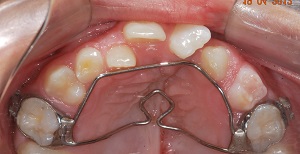Vol. 14 – Number 54 – 2021 Case report Page 80-88 Cleft lip and palate bone anchored maxillary protraction in miniplates – from diagnosis to skeletal maturity Renata Mayumi Kato1 Renato André de Souza Faco2 Hilde Timmerman3 Hugo De Clerck4 Daniela Garib5 Abstract The purpose of this study was to report a case with complete unilateral cleft lip and palate (CLP) treated with bone anchored maxillary protraction (BAMP) in miniplates followed up until the end of facial growth. A 7-year-old girl with complete left side CLP started the orthodontic treatment in a rehabilitation center. She presented a Class III skeletal pattern due to maxillary deficiency, a GOSLON 4 sagittal interarch relationship, a negative overjet of 1.5mm and agenesis of left upper lateral incisor. In the mixed dentition, the patient was submitted to rapid maxillary expansion followed by the secondary alveolar bone grafting procedure. At 12y 3m two miniplates were installed in the maxilla and two in the mandible with BAMP therapy. The patient was instructed to use full time Class III elastics with force of 250g/side together with a bite lifting plate in the upper arch. BAMP therapy duration was 19 months leading to a positive overjet and GOSLON 1 sagittal interarch relationship. The cephalometric analysis demonstrated a mild maxilla advancement. Class III elastics started to be used only at night as an active retention concomitantly with Phase II orthodontic treatment. Compensatory corrective orthodontic treatment established adequate occlusion between the dental arches with significant improvement of facial aesthetics after the intervention. Le Fort 1 surgery with maxillary advancement was not necessary. Descriptors: Cleft lip, cleft palate, interceptive Orthodontics. 1 Orthodontics Department, Hospital for Rehabilitation of Craniofacial Anomalies – USP. 2 Oral and Maxillofacial Surgery Department, Hospital of Rehabilitation of Craniofacial Anomalies – USP. 3 Private Practice – Brussels – Belgium. 4 Department of Orthodontics, University of North Carolina, North Carolina, USA. 5 Orthodontics Sector, Hospital for Rehabilitation of Craniofacial Anomalies and Department of Orthodontics – FOB-USP. DOI: 10.24077/2021;1454-8088
This content is restricted to site members. If you are an existing user, please log in. New users may register below.




